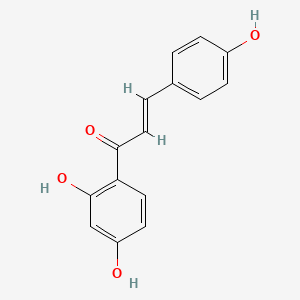| Kang SW et al. |
Licorice isoliquiritigenin dampens angiogenic activity via inhibition of MAPK-responsive signaling pathways leading to induction of matrix metalloproteinases. |
2010 |
J. Nutr. Biochem. |
pmid:19157825
|
| Park I et al. |
Isoliquiritigenin induces G2 and M phase arrest by inducing DNA damage and by inhibiting the metaphase/anaphase transition. |
2009 |
Cancer Lett. |
pmid:19167809
|
| Lee SH et al. |
Isoliquiritigenin, from Dalbergia odorifera, up-regulates anti-inflammatory heme oxygenase-1 expression in RAW264.7 macrophages. |
2009 |
Inflamm. Res. |
pmid:19169644
|
| Zu Y et al. |
Cytotoxic activity of isoliquiritigenin towards CCRF-CEM leukemia cells and its effect on DNA damage. |
2009 |
Planta Med. |
pmid:19291608
|
| Lee YM et al. |
Induction of cell cycle arrest in prostate cancer cells by the dietary compound isoliquiritigenin. |
2009 |
J Med Food |
pmid:19298190
|
| Jeon JP et al. |
Proteomic and behavioral analysis of response to isoliquiritigenin in brains of acute cocaine treated rats. |
2008 |
J. Proteome Res. |
pmid:19367698
|
| Hsu YL et al. |
Shallot and licorice constituent isoliquiritigenin arrests cell cycle progression and induces apoptosis through the induction of ATM/p53 and initiation of the mitochondrial system in human cervical carcinoma HeLa cells. |
2009 |
Mol Nutr Food Res |
pmid:19536869
|
| Farag MA et al. |
Integrated metabolite and transcript profiling identify a biosynthetic mechanism for hispidol in Medicago truncatula cell cultures. |
2009 |
Plant Physiol. |
pmid:19571306
|
| Yoon G et al. |
Inhibitory effect of chalcones and their derivatives from Glycyrrhiza inflata on protein tyrosine phosphatase 1B. |
2009 |
Bioorg. Med. Chem. Lett. |
pmid:19632832
|
| Youn UJ et al. |
Identification of antiadipogenic constituents of the rhizomes of Anemarrhena asphodeloides. |
2009 |
J. Nat. Prod. |
pmid:19757853
|
| Park SJ et al. |
Suppression of the TRIF-dependent signaling pathway of toll-like receptors by isoliquiritigenin in RAW264.7 macrophages. |
2009 |
Mol. Cells |
pmid:19809799
|
| Lee MJ et al. |
Protective effects of isoliquiritigenin against methamphetamine-induced neurotoxicity in mice. |
2009 |
J. Pharmacol. Sci. |
pmid:19834288
|
| Srinivasan B et al. |
Structure-activity relationship studies of chalcone leading to 3-hydroxy-4,3',4',5'-tetramethoxychalcone and its analogues as potent nuclear factor kappaB inhibitors and their anticancer activities. |
2009 |
J. Med. Chem. |
pmid:19883086
|
| Shibano M et al. |
Determination of flavonoids in licorice using acid hydrolysis and reversed-phase HPLC and evaluation of the chemical quality of cultivated licorice. |
2010 |
Planta Med. |
pmid:20013636
|
| Choi SH et al. |
AMPK-mediated GSK3beta inhibition by isoliquiritigenin contributes to protecting mitochondria against iron-catalyzed oxidative stress. |
2010 |
Biochem. Pharmacol. |
pmid:20026081
|
| Lau GT et al. |
The licorice flavonoid isoliquiritigenin suppresses phorbol ester-induced cyclooxygenase-2 expression in the non-tumorigenic MCF-10A breast cell line. |
2010 |
Planta Med. |
pmid:20033868
|
| Cuendet M et al. |
Cancer chemopreventive activity and metabolism of isoliquiritigenin, a compound found in licorice. |
2010 |
Cancer Prev Res (Phila) |
pmid:20068129
|
| Li J et al. |
Isoliquiritigenin entails blockade of TGF-beta1-SMAD signaling for retarding high glucose-induced mesangial matrix accumulation. |
2010 |
J. Agric. Food Chem. |
pmid:20146476
|
| Park SJ and Youn HS |
Isoliquiritigenin suppresses the Toll-interleukin-1 receptor domain-containing adapter inducing interferon-beta (TRIF)-dependent signaling pathway of Toll-like receptors by targeting TBK1. |
2010 |
J. Agric. Food Chem. |
pmid:20356041
|
| Zhang X et al. |
Isoliquiritigenin, a natural anti-oxidant, selectively inhibits the proliferation of prostate cancer cells. |
2010 |
Clin. Exp. Pharmacol. Physiol. |
pmid:20456427
|
